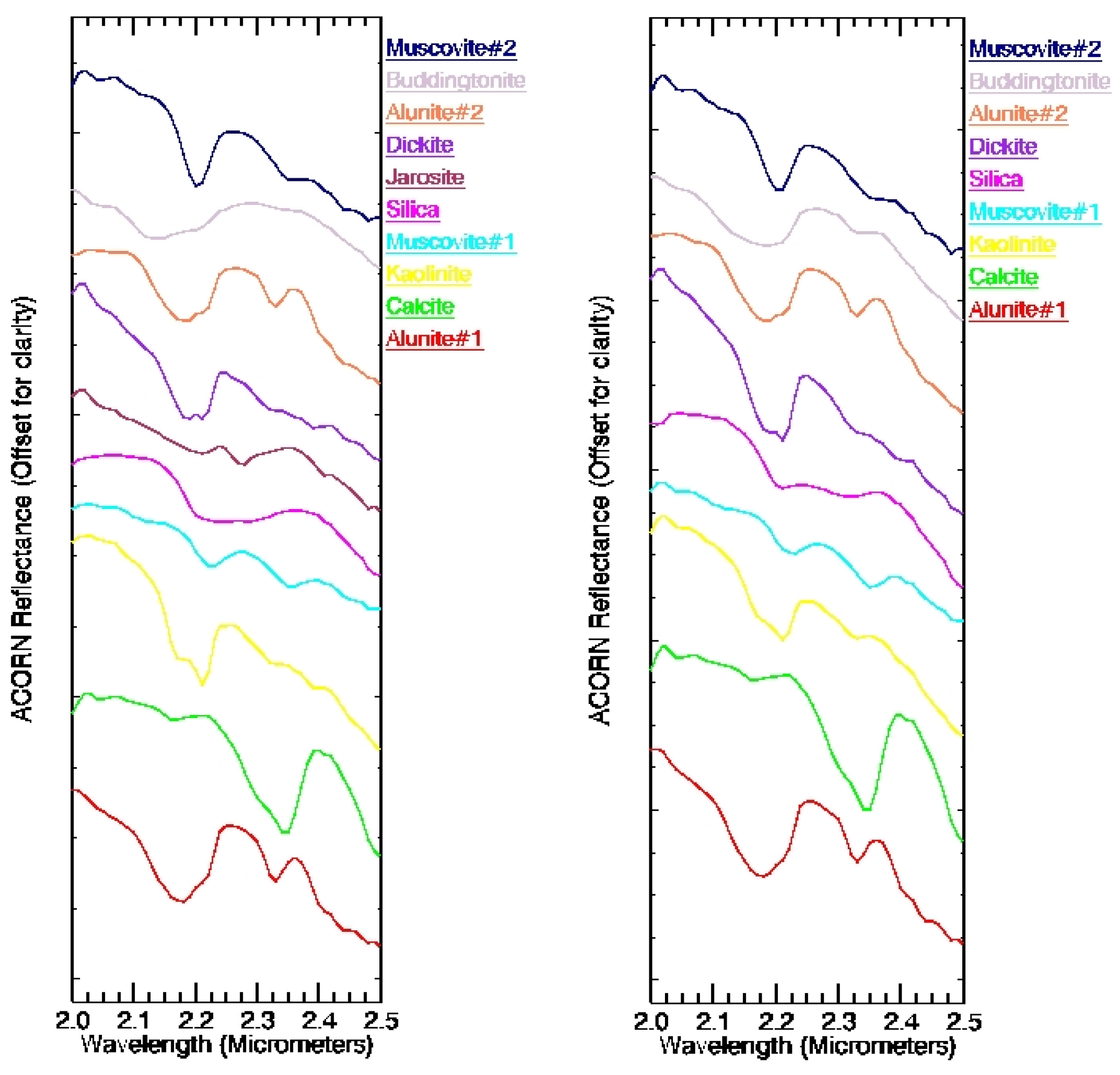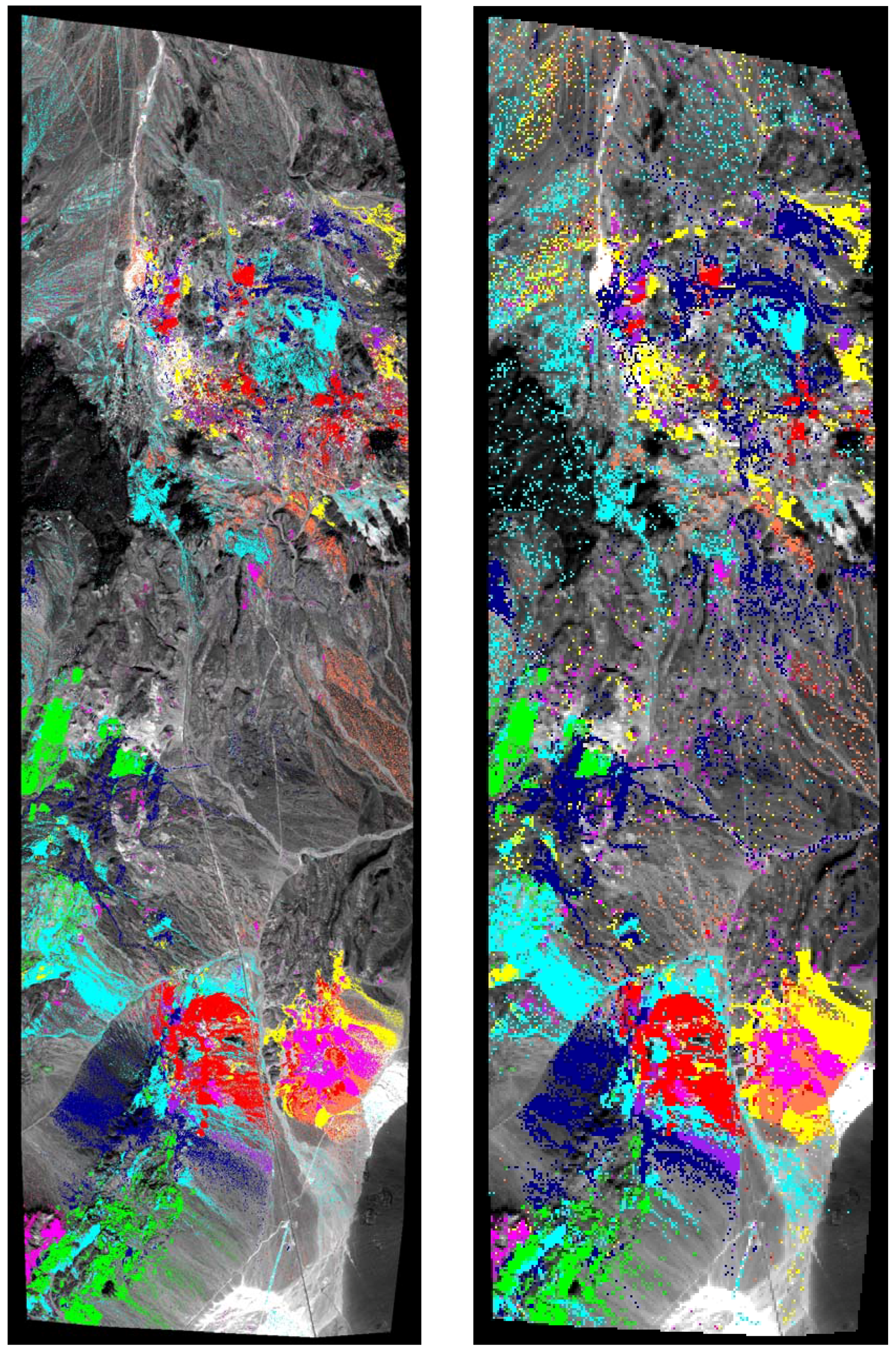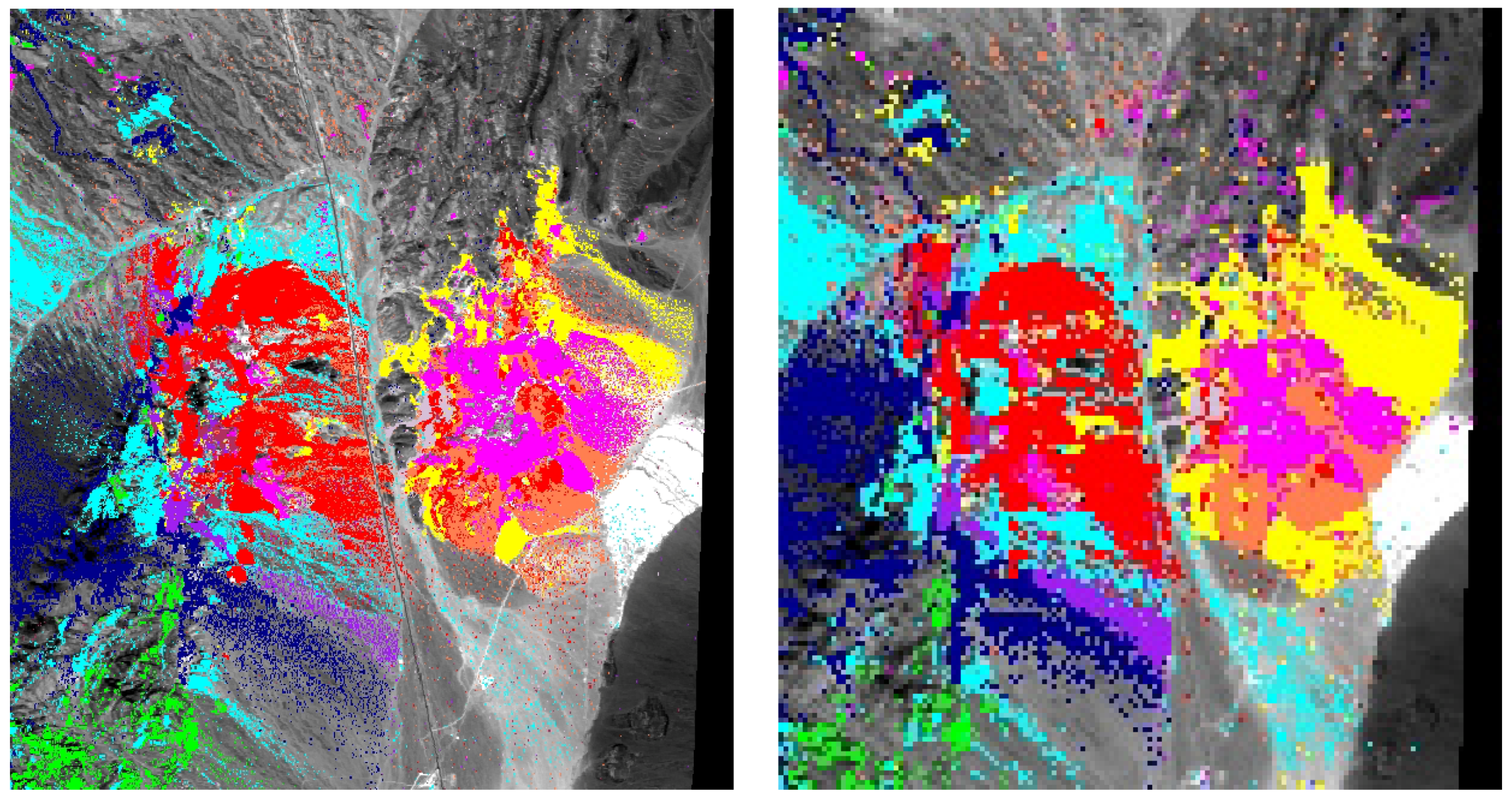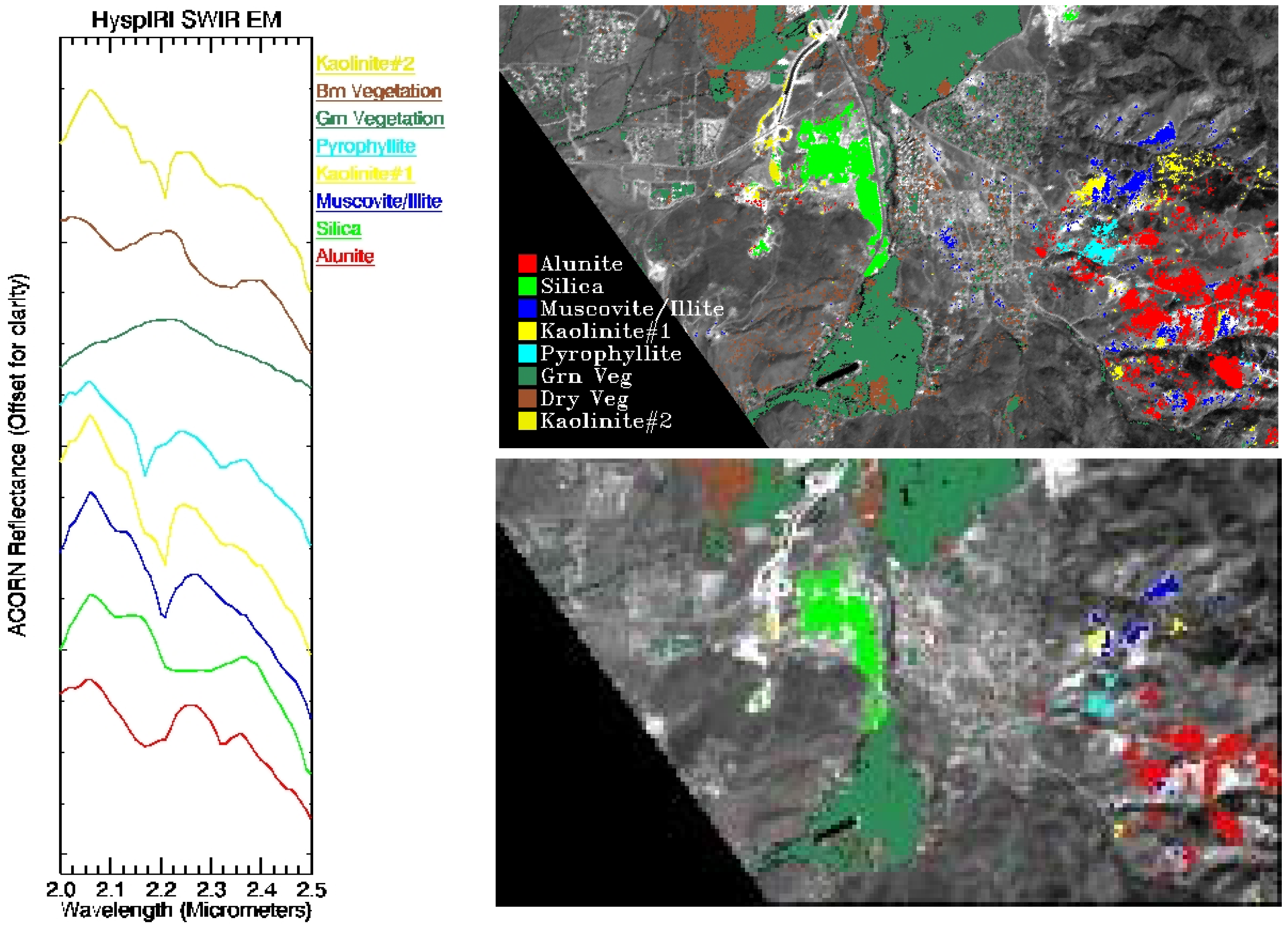Effect of Reduced Spatial Resolution on Mineral Mapping Using Imaging Spectrometry—Examples Using Hyperspectral Infrared Imager (HyspIRI)-Simulated Data
Abstract
:1. Introduction
2. Approach and Methods
3. Results and Discussion
3.1. Cuprite, NV, Site (Fossil Hydrothermal System)



| Ground | Truth | ||||||||||||||
| Class | Unclass | Alun#1 | Calcite | Kaolinite | Musc#1 | Silica | Dickite | Alun#2 | Budding. | Musc#2 | Total | ||||
| Unclass | 84.01 | 16.52 | 24.99 | 5.83 | 32.64 | 11.25 | 22.85 | 42.74 | 51.74 | 19.22 | 74.82 | ||||
| Alun#1 | 0.52 | 63.83 | 0.02 | 0.91 | 1.07 | 0.44 | 2.71 | 8.21 | 2.54 | 0.21 | 1.98 | ||||
| Calcite | 0.63 | 0.02 | 66.58 | 0.01 | 0.55 | 0.09 | 0.09 | 0.02 | 0.56 | 0.35 | 1.80 | ||||
| Kaolinite | 2.42 | 3.36 | 0.22 | 84.84 | 2.85 | 11.50 | 5.03 | 10.53 | 4.01 | 0.93 | 3.58 | ||||
| Musc#1 | 4.20 | 2.42 | 5.63 | 0.73 | 57.25 | 1.78 | 3.56 | 1.75 | 9.35 | 0.44 | 6.19 | ||||
| Silica | 0.89 | 0.22 | 0.14 | 0.13 | 0.34 | 67.63 | 0.14 | 2.41 | 1.52 | 0.28 | 1.53 | ||||
| Dickite | 0.45 | 1.67 | 0.00 | 4.21 | 0.51 | 0.01 | 53.93 | 0.16 | 0.14 | 0.72 | 0.86 | ||||
| Alun#2 | 1.35 | 9.03 | 0.05 | 1.16 | 0.64 | 6.50 | 0.32 | 32.47 | 0.84 | 0.19 | 2.08 | ||||
| Budding. | 0.09 | 0.51 | 0.06 | 0.29 | 0.16 | 0.01 | 0.06 | 0.21 | 24.11 | 0.04 | 0.16 | ||||
| Musc#2 | 5.43 | 2.42 | 2.31 | 1.90 | 3.99 | 0.79 | 11.31 | 1.49 | 5.20 | 77.62 | 7.01 | ||||
| Total | 100.00 | 100.00 | 100.00 | 100.00 | 100.00 | 100.00 | 100.00 | 100.00 | 100.00 | 100.00 | 100.00 | ||||
| Class | Commission | Omission | Prod. Acc. | User Acc. | |||||||||||
| Percent | Percent | Percent | Percent | ||||||||||||
| Unclass | 5.28 | 15.97 | 84.03 | 94.72 | |||||||||||
| Alun#1 | 34.91 | 36.17 | 63.83 | 65.09 | |||||||||||
| Calcite | 31.27 | 33.42 | 66.58 | 68.73 | |||||||||||
| Kaol | 73.24 | 15.16 | 84.84 | 26.76 | |||||||||||
| Musc#1 | 61.56 | 42.75 | 57.25 | 38.44 | |||||||||||
| Silica | 54.59 | 32.37 | 67.63 | 45.41 | |||||||||||
| Dickite | 58.42 | 46.07 | 53.93 | 41.58 | |||||||||||
| Alun#2 | 69.22 | 67.53 | 32.47 | 30.78 | |||||||||||
| Budding. | 65.21 | 75.89 | 24.11 | 34.79 | |||||||||||
| Musc#2 | 71.08 | 22.38 | 77.62 | 28.92 | |||||||||||
3.2. Steamboat, NV, Site (Active Geothermal System)

| Ground | Truth | ||||||||||||||
| Class | Unclass | Alunite | Silica | Mus/Ill | Kaol#1 | Pyroph | G. Veg | D. Veg | Kaol#2 | Total | |||||
| Unclass | 98.02 | 55.35 | 20.06 | 75.08 | 83.11 | 58.39 | 18.77 | 60.21 | 77.21 | 88.43 | |||||
| Alunite | 0.20 | 44.58 | 0.00 | 0.20 | 0.07 | 0.13 | 0.00 | 0.01 | 0.00 | 1.30 | |||||
| Silica | 0.19 | 0.01 | 79.73 | 0.00 | 0.00 | 0.00 | 0.00 | 0.19 | 0.00 | 1.31 | |||||
| Mus/Ill | 0.08 | 0.04 | 0.00 | 24.56 | 0.83 | 0.00 | 0.00 | 0.00 | 0.00 | 0.28 | |||||
| Kaol#1 | 0.03 | 0.00 | 0.00 | 0.08 | 15.15 | 0.00 | 0.00 | 0.00 | 1.33 | 0.10 | |||||
| Pyroph | 0.03 | 0.01 | 0.00 | 0.00 | 0.00 | 41.49 | 0.00 | 0.00 | 0.00 | 0.13 | |||||
| G. Veg | 0.95 | 0.00 | 0.14 | 0.00 | 0.00 | 0.00 | 80.41 | 4.77 | 0.00 | 7.03 | |||||
| D. Veg | 0.48 | 0.00 | 0.02 | 0.08 | 0.00 | 0.00 | 0.82 | 34.82 | 0.00 | 1.38 | |||||
| Kaol#2 | 0.01 | 0.00 | 0.05 | 0.00 | 0.83 | 0.00 | 0.00 | 0.00 | 21.46 | 0.05 | |||||
| Total | 100.00 | 100.00 | 100.00 | 100.00 | 100.00 | 100.00 | 100.00 | 100.00 | 100.00 | 100.00 | |||||
| Class | Commission | Omission | Prod. Acc. | User Acc. | |||||||||||
| Percent | Percent | Percent | Percent | ||||||||||||
| Unclass | 6.76 | 1.98 | 98.02 | 93.24 | |||||||||||
| Alunite | 13.34 | 55.42 | 44.58 | 86.66 | |||||||||||
| Silica | 12.63 | 20.27 | 79.73 | 87.37 | |||||||||||
| Mus/Ill | 25.96 | 75.44 | 24.56 | 74.04 | |||||||||||
| Kaol#1 | 28.29 | 84.85 | 15.15 | 71.71 | |||||||||||
| Pyroph | 19.00 | 58.51 | 41.49 | 81.00 | |||||||||||
| G. Veg | 13.18 | 19.59 | 80.41 | 86.82 | |||||||||||
| D. Veg | 33.93 | 65.18 | 34.82 | 66.07 | |||||||||||
| Kaol#2 | 32.64 | 78.54 | 21.46 | 67.36 | |||||||||||
3.3. Yellowstone, WY Site (Active Geothermal System)


| Ground | Truth | |||||
| Class | Unclass | Kaolinite | Silica | Grn Veg | Dry Veg | Total |
| Unclass | 76.89 | 49.41 | 12.86 | 35.44 | 51.63 | 68.03 |
| Kaolinite | 1.12 | 19.15 | 0.36 | 0.45 | 1.03 | 1.11 |
| Silica | 0.93 | 3.18 | 69.17 | 2.34 | 1.41 | 2.84 |
| Grn Veg | 5.62 | 5.61 | 8.76 | 56.01 | 3.06 | 9.82 |
| Dry Veg | 15.44 | 22.65 | 8.85 | 5.77 | 42.66 | 18.20 |
| Total | 100.00 | 100.00 | 100.00 | 100.00 | 100.00 | 100.00 |
| Class | Commission | Omission | Prod. Acc. | User Acc. | ||
| Percent | Percent | Percent | Percent | |||
| Unclass | 15.93 | 23.11 | 76.89 | 84.07 | ||
| Kaolinite | 92.49 | 80.85 | 19.15 | 7.51 | ||
| Silcia | 39.09 | 30.83 | 69.17 | 60.91 | ||
| Grn Veg | 49.33 | 43.99 | 56.01 | 50.67 | ||
| Dry Veg | 67.65 | 57.34 | 42.66 | 32.35 |
4. Conclusions
Availability of Simulated Data
Acknowledgments
References
- Goetz, A.F.H.; Vane, G.; Solomon, J.E.; Rock, B.N. Imaging spectrometry for earth remote sensing. Science 1985, 228, 1147–1153. [Google Scholar] [CrossRef] [PubMed]
- Kruse, F.A.; Perry, S.L. Improving multispectral mapping by spectral modeling with hyperspectral signatures. J. Appl. Remote Sens. 2009, 3, 033504. [Google Scholar]
- Hamilton, M.K.; Davis, C.O.; Rhea, W.J.; Pilorz, S.H.; Carder, K.L. Estimating chlorophyll content and bathymetry of Lake Tahoe using AVIRIS data. Remote Sens. Environ. 1993, 44, 217–230. [Google Scholar] [CrossRef]
- Roberts, D.A.; Smith, M.O.; Adams, J.B. Green vegetation, nonphotosynthetic vegetation, and soils in AVIRIS data. Remote Sens. Environ. 1993, 44, 255–269. [Google Scholar] [CrossRef]
- Clark, R.N.; Swayze, G.A.; Rowan, L.C.; Livo, K.E.; Watson, K. Mapping Surficial Geology, Vegetation Communities, and Environmental Materials in our National Parks: The USGS Imaging Spectroscopy Integrated Geology, Ecosystems, and Environmental Mapping Project. In Proceedings of Summaries of the 6th Annual JPL Airborne Earth Science Workshop, Pasadena, CA, USA, 4–8 March 1996; Volume 1, pp. 55–56.
- Green, R.O.; Dozier, J. Retrieval of Surface Snow Grain Size and Melt Water from AVIRIS Spectra. In Proceedings of the 6th Annual JPL Airborne Earth Science Workshop, Pasadena, CA, USA, 4–8 March 1996; Volume 1, pp. 127–134.
- Asner, G.P.; Green, R.O. Imaging spectroscopy measures desertification in the Southwest U.S. and Argentina. Eos Trans. AGU 2001, 80, 601–605. [Google Scholar] [CrossRef]
- Ungar, S.; Pearlman, J.; Mendenhall, J.; Reuter, D. Overview of the EARTH Observing One (EO-1) mission. IEEE Trans. Geosci. Remote Sens. 2003, 41, 1149–1159. [Google Scholar] [CrossRef]
- Taranik, J.V.; Aslett, Z.L. Development of hyperspectral imaging for mineral exploration. Rev. Econ. Geol. 2009, 16, 83–95. [Google Scholar]
- Kruse, F.A. Use of Airborne Imaging Spectrometer data to map minerals associated with hydrothermally altered rocks in the northern Grapevine Mountains, Nevada and California. Remote Sens. Environ. 1988, 24, 31–51. [Google Scholar] [CrossRef]
- Kruse, F.A.; Boardman, J.W.; Huntington, J.F. Evaluation and validation of EO-1 Hyperion for mineral mapping. IEEE Trans. Geosci. Remote Sens. 2003, 41, 1388–1400. [Google Scholar] [CrossRef]
- Kruse, F.A.; Perry, S.L.; Caballero, A. District-level mineral survey using airborne hyperspectral data, Los Menucos, Argentina. Ann. Geophys. 2006, 19, 83–92. [Google Scholar]
- Kratt, C.; Calvin, W.; Coolbaugh, M. Geothermal exploration with Hymap hyperspectral data at Brady–Desert Peak, Nevada. Remote Sens. Environ. 2006, 104, 313–324. [Google Scholar] [CrossRef]
- Livo, K.E.; Kruse, F.A.; Clark, R.N.; Kokaly, R.F.; Shanks, W.C., III. Hydrothermally altered rock and Hot-Spring Deposits at Yellowstone National Park—Characterized using airborne visible- and infrared-spectroscopy data. In Integrated Geoscience Studies in the Greater Yellowstone Area—Volcanic, Tectonic, and Hydrothermal Processes in the Yellowstone Geoecosystem; US Geological Survey Professional Paper 1717; USGS: Reno, NV, USA, 2007; Chapter O; pp. 493–505. [Google Scholar]
- NRC. National Research Council Committee on Earth Science and Applications from Space, Earth science and Applications from Space, National Imperatives for the Next Decade and Beyond; The National Academies Press: Washington, DC, USA, 2007. [Google Scholar]
- Kruse, F.A.; Coolbaugh, M.F.; Taranik, J.V.; Calvin, W.M.; Littlefield, E.F.; Michaels, J.; Martini, B.A. Characterization of Hydrothermal Systems Using Simulated Hyperspectral Infrared Imager (HysPIRI) Data. In Proceedings 2011 IEEE AeroSpace Conference, Big Sky, MT, USA, 5–12 March 2011.
- Porter, W.M.; Enmark, H.E. System overview of the Airborne Visible/Infrared Imaging Spectrometer (AVIRIS). SPIE 1987, 834, 22–31. [Google Scholar]
- Green, R.O.; Cone, J.E.; Margolis, J.; Chovit, C.; Faust, J. In-Flight Calibration and Validation of the Airborne Visible/Infrared Imaging Spectrometer (AVIRIS). In Proceedings of the 6th Annual JPL Airborne Earth Science Workshop, Pasadena, CA, USA, 4–8 March 1996; Volume 1, pp. 115–126.
- Green, R.O.; Eastwood, M.L.; Sarture, C.M. Imaging Spectroscopy and the Airborne Visible Infrared Imaging Spectrometer (AVIRIS). Remote Sens. Environ. 1998, 65, 227–248. [Google Scholar] [CrossRef]
- Green, R.O. AVIRIS and related 21st century imaging spectrometers for earth and space science. In High Performance Computing in Remote Sensing; Chapman and Hall/CRC: Boca Raton, FL, USA, 2007; pp. 335–358. [Google Scholar]
- Yamaguchi, Y.; Kahle, A.B.; Tsu, H.; Kawakami, T.; Pniel, M. Overview of advanced spaceborne thermal emission reflectance radiometer. IEEE Trans. Geosci. Remote Sens. 1998, 36, 1062–1071. [Google Scholar] [CrossRef]
- IMSPEC LLC. ACORN 6 User’s Manual; IMSPEC LLC: Palmdale, CA, USA, 2010; p. 121. [Google Scholar]
- Kruse, F.A. Comparison of ATREM, ACORN, and FLAASH Atmospheric Corrections Using Low-Altitude AVIRIS Data of Boulder, Colorado. In Proceedings 13th JPL Airborne Geoscience Workshop, Jet Propulsion Laboratory, Pasadena, CA, USA, 31 March–2 April 2004. JPL Publication 05-3.
- Kruse, F.A. Mapping surface mineralogy using imaging spectrometry. Geomorphology 2011. [Google Scholar] [CrossRef]
- Green, A.A.; Berman, M.; Switzer, P.; Craig, M.D. A Transformation for ordering multispectral data in terms of image quality with implications for noise removal. IEEE Trans. Geosci. Remote Sens. 1988, 26, 65–74. [Google Scholar] [CrossRef]
- Boardman, J.W. Automated Spectral Unmixing of AVIRIS Data Using Convex Geometry Concepts. In Proceedings of Summaries 4th JPL Airborne Geoscience Workshop, Pasadena, CA, USA, 25–29 October 1993; Volume 1, pp. 11–14.
- Boardman, J.W.; Kruse, F.A. Automated Spectral Analysis: A Geological Example Using AVIRIS Data, Northern Grapevine Mountains, Nevada. In Proceedings of Tenth Thematic Conference, Geologic Remote Sensing, San Antonio, TX, USA, 9–12 May 1994. I-407-I-418.
- Boardman, J.W. Analysis, understanding and visualization of hyperspectral data as convex sets in n-space. Proc. SPIE 1995, 2480, 14–22. [Google Scholar]
- Boardman, J.W. Leveraging the High Dimensionality of AVIRIS Data for Improved Sub-Pixel Target Unmixing and Rejection of False Positives: Mixture Tuned Matched Filtering. In Proceedings of Summaries of the Seventh Annual JPL Airborne Geoscience Workshop, Pasadena, CA, USA, 12–16 January 1998; Volume 1, p. 55.
- Swayze, G.A. The Hydrothermal and Structural History of the Cuprite Mining District, Southwestern Nevada: An Integrated Geological and Geophysical Approach. Ph.D. Dissertation, University of Colorado Boulder, Boulder, CO, USA, 1997. [Google Scholar]
- Abrams, M.J.; Ashley, R.P.; Rowan, L.C.; Goetz, A.F.H.; Kahle, A.B. Mapping of hydrothermal alteration in the Cuprite mining district, Nevada, using aircraft scanner images for the spectral region 0.46–2.36 micrometers. Geology 1977, 5, 713–718. [Google Scholar] [CrossRef]
- Clark, R.N.; Swayze, G.A.; Wise, R.; Livo, E.; Hoefen, T.; Kokaly, R.; Sutley, S.J. USGS Digital Spectral Library splib06a; Digital Data Series 231; US Geological Survey, 2007. Available online: http://speclab.cr.usgs.gov/spectral.lib06 (accessed on 18 July 2011).
- Richards, J.A.; Jia, X. Remote Sensing Digital Image Analysis: An introduction, 4th ed.; Springer: Berlin, Germany, 2006. [Google Scholar]
- Monserud, R.A.; Leemans, R. Comparing global vegetation maps with the Kappa-Statistic. Ecol. Modell. 1992, 62, 275–293. [Google Scholar] [CrossRef]
- Landis, J.R.; Koch, G.G. The measurement of observer agreement for categorical data. Biometrics 1977, 33, 159–174. [Google Scholar] [CrossRef] [PubMed]
- White, D.E. Thermal springs and epithermal ore deposits. Econ. Geol. 1955, 50, 99–154. [Google Scholar]
- White, D.E. Some principles of geyser activity, mainly from Steamboat Springs, Nevada. Am. J. Sci. 1967, 265, 641–684. [Google Scholar] [CrossRef]
- Silberman, M.L.; White, D.E.; Keith, T.E.C.; Docktor, R.D. Duration of Hydrothermal Activity at Steamboat Springs, Nevada, From Ages of the Spatially Associated Volcanic Rock; US Geological Survey Professional Paper 458-D; US GPO: Washington, DC, USA, 1979.
- White, D.E.; Thompson, G.A.; Sanberg, C.S. Rocks, Structure, and Geologic History of Steamboat Springs Thermal Area, Washoe County, Nevada; US Geological Survey Professional Paper 458-B; US GPO: Washington, DC, USA, 1964.
- Sigvaldason, G.E.; White, D.E. Hydrothermal Alteration in Drill Holes GS-5 and GS-7, Steamboat Springs, Nevada; US Geological Survey Professional Paper 450-D; US GPO: Washington, DC, USA, 1962; pp. D113–D117.
- White, D.E.; Anderson, E.T.; Grubbs, D.K. Geothermal brine well/mile-deep drill hole may tap ore-bearing magmatic water and rocks undergoing metamorphism. Science 1963, 139, 919–922. [Google Scholar] [CrossRef] [PubMed]
- Schoen, R.; White, D.E. Hydrothermal Alteration of Basaltic Andesite and Other Rocks in Drill Hole GS-6, Steamboat Springs, Nevada; US Geological Survey Professional Paper 575-B; US GPO: Washington, DC, USA, 1967; pp. 110–119.
- Schoen, R.; White, D.E.; Hemley, J.J. Argillization by descending acid at Steamboat Springs, Nevada. Clays Clay Minerals 1974, 22, 1–22. [Google Scholar] [CrossRef]
- White, D.E. Active geothermal systems and hydrothermal ore deposits. Econ. Geol. 1981, 75, 392–423. [Google Scholar]
- White, D.E.; Heropoulos, C.; Fournier, R.O. Gold and Other Minor Elements Associated with the Hot Springs and Geysers of Yellowstone National Park, Wyoming, Supplemented with Data from Steamboat Springs, Nevada; U.S. Geological Survey Bulletin 2001; US GPO: Washington, DC, USA, 1992; p. 10.
- Kruse, F.A. Characterization of Active Hot-Springs Environments Using Multispectral and Hyperspectral Remote Sensing. In Proceedings of 12th Thematic Conference, Applied Geologic Remote Sensing, Ann Arbor, MI, USA, 17–19 November 1997. I-214-I-221.
- Kruse, F.A. Mapping Hot Spring Deposits with AVIRIS at Steamboat Springs, Nevada. In Proceedings of the 8th JPL Airborne Earth Science Workshop, Pasadena, CA, USA, 8–11 February 1999; Jet Propulsion Laboratory Publication 99-17. pp. 239–246.
- Coolbaugh, M.F.; Taranik, J.V.; Kruse, F.A. Mapping of surface geothermal anomalies at Steamboat Springs, NV. using NASA Thermal Infrared Multispectral Scanner (TIMS) and Advanced Visible and Infrared Imaging Spectrometer (AVIRIS) data. In Proceedings of 14th Thematic Conference, Applied Geologic Remote Sensing, Las Vegas, NV, USA, 6–8 November 2000; pp. 623–630.
- Rhinehart, J.S. Geysers and Geothermal Energy; Springer-Verlag.: New York, NY, USA, 1980. [Google Scholar]
- Bryan, T.S. The Geysers of Yellowstone; Colorado Associated University Press: Boulder, CO, USA, 1986. [Google Scholar]
- Ruppel, E.T. Geology of Pre-Tertiary Rocks in the Northern Part of Yellowstone National Park, Wyoming; US Geological Survey Professional Paper 729-A; US GPO: Washington, DC, USA, 1972.
- Breckenridge, R.M.; Hinckley, B.S. Thermal Springs of Wyoming; Geological Survey of Wyoming Bulletin 60; US GPO: Washington, DC, USA, 1978.
- White, D.E.; Hutchinson, R.A.; Keith, T.E.C. The Geology and Remarkable Thermal Activity of Norris Geyser Basin, Yellowstone National Park, Wyoming; US Geological Survey Professional Paper 1456; US GPO: Washington, DC, USA, 1988.
- Eaton, G.P.; Christiansen, R.L.; Lyer, H.M.; Pitt, A.M.; Mabey, D.R.; Blank, H.R.J.; Zietz, I.; Gettings, M.E. Magma beneath Yellowstone National Park. Science 1975, 188, 787–796. [Google Scholar] [CrossRef] [PubMed]
- Pierce, K.L. History and Dynamics of Glaciation in the Northern Yellowstone Park Area; US Geological Survey Professional Paper 729-F; US GPO: Washington, DC, USA, 1979.
- Sorey, M.L. Geothermal Development and Changes in Surficial Features: Examples from the Western United States. In Proceedings of World Geothermal Congress 2000, Tohoku, Japan, 28 May–10 June 2000; pp. 705–711.
© 2011 by the authors; licensee MDPI, Basel, Switzerland. This article is an open access article distributed under the terms and conditions of the Creative Commons Attribution license (http://creativecommons.org/licenses/by/3.0/).
Share and Cite
Kruse, F.A.; Taranik, J.V.; Coolbaugh, M.; Michaels, J.; Littlefield, E.F.; Calvin, W.M.; Martini, B.A. Effect of Reduced Spatial Resolution on Mineral Mapping Using Imaging Spectrometry—Examples Using Hyperspectral Infrared Imager (HyspIRI)-Simulated Data. Remote Sens. 2011, 3, 1584-1602. https://doi.org/10.3390/rs3081584
Kruse FA, Taranik JV, Coolbaugh M, Michaels J, Littlefield EF, Calvin WM, Martini BA. Effect of Reduced Spatial Resolution on Mineral Mapping Using Imaging Spectrometry—Examples Using Hyperspectral Infrared Imager (HyspIRI)-Simulated Data. Remote Sensing. 2011; 3(8):1584-1602. https://doi.org/10.3390/rs3081584
Chicago/Turabian StyleKruse, Fred A., James V. Taranik, Mark Coolbaugh, Joshua Michaels, Elizabeth F. Littlefield, Wendy M. Calvin, and Brigette A. Martini. 2011. "Effect of Reduced Spatial Resolution on Mineral Mapping Using Imaging Spectrometry—Examples Using Hyperspectral Infrared Imager (HyspIRI)-Simulated Data" Remote Sensing 3, no. 8: 1584-1602. https://doi.org/10.3390/rs3081584




